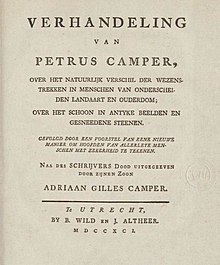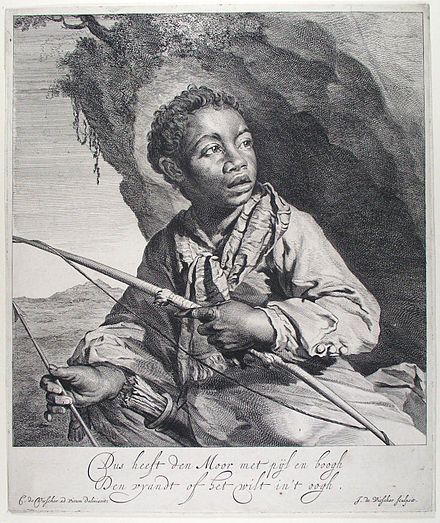
Karel van Mander (I) or Carel van Mander I was a Flemish painter, poet, art historian and art theoretician, who established himself in the Dutch Republic in the latter part of his life. He is mainly remembered as a biographer of Early Netherlandish painters and Northern Renaissance artists in his Schilder-boeck. As an artist and art theoretician he played a significant role in the spread and development of Northern Mannerism in the Dutch Republic.

Petrus Camper FRS, was a Dutch physician, anatomist, physiologist, midwife, zoologist, anthropologist, palaeontologist and a naturalist in the Age of Enlightenment. He was one of the first to take an interest in comparative anatomy, palaeontology, and the facial angle. He was among the first to mark out an "anthropology," which he distinguished from natural history. He studied the orangutan, the javan rhinoceros, and the skull of a mosasaur, which he believed was a whale. Camper was a celebrity in Europe and became a member of the Royal Society (1750), the Göttingen (1779), and Russian Academy of Sciences (1778), the Royal Society of Edinburgh (1783), the French (1786) and the Prussian Academy of Sciences (1788). He designed and constructed tools for his patients, and for surgeries. He was amateur-drawer, a sculptor, a patron of art and a conservative, royalist politician. Camper published some lectures containing an account of his craniometrical methods. These laid the foundation of all subsequent work.

Pierre Lyonnet or Lyonet was an artist and engraver who became a naturalist. He was a collector both of shells and paintings, whose collection included Woman Reading a Letter by Vermeer, now in the Rijksmuseum. This fetched far less than his best shells in the auctions of his collection after his death.

Cornelis or Cornelius Ketel was a Dutch Mannerist painter, active in Elizabethan London from 1573 to 1581, and in Amsterdam from 1581 to the early 17th century, now known essentially as a portrait-painter, though he was also a poet and orator, and from 1595 began to sculpt as well.
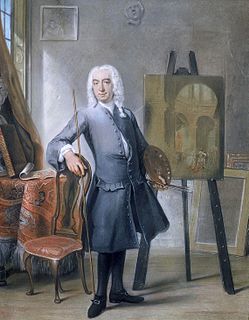
Cornelis Troost was an 18th-century actor and painter from Amsterdam.

Jacob Gijsbertus Samuël van Breda was a Dutch biologist and geologist.

Jan Verkolje or Johannes Verkolje was a Dutch painter, draughtsman and engraver. He is mainly known for his portraits and genre pieces of elegant couples in interiors and, to a lesser extent, for his religious and mythological compositions. He was a gifted mezzotint artist. Trained in Amsterdam Verkolje spent his active professional career in Delft where he had access to powerful patrons.
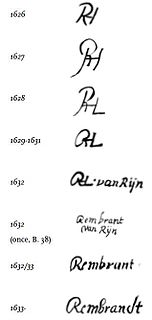
The Rembrandt Research Project (RRP) is an initiative of the Nederlandse Organisatie voor Wetenschappelijk Onderzoek (NWO), which is the Netherlands Organization for Scientific Research. Its purpose is to organize and categorize research on Rembrandt van Rijn, with the aim of discovering new facts about this Dutch Golden Age painter and his studio. The project was started in 1968, but has since become the authority on Rembrandt and has the final say in whether a painting is genuine.
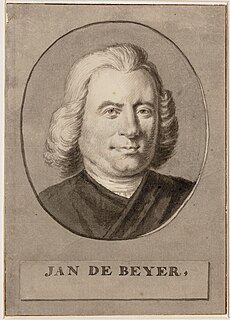
Jan de Beijer, also given as Jan de Beyer, was a Dutch draughtsman and painter known for this drawings of towns and buildings in the present-day countries of the Netherlands, Belgium and Germany. In total, he produced some 1500 drawings, over 600 of which were reproduced as engravings by other artists.
Cornelis Bos or Bossche was a Flemish engraver, printseller and book publisher, known for his accurate engravings of Italian works. His work is often signed with the monogram C-B.

Cornelis Visscher, was a Dutch Golden Age engraver and the brother of Jan de Visscher and Lambert Visscher.

Hendrik Kobell was an 18th-century landscape and marine painter, etcher, draftsman and watercolorist from the Northern Netherlands.

Skull of a Skeleton with Burning Cigarette is an early work by Vincent van Gogh. The small and undated oil-on-canvas painting featuring a skeleton and cigarette is part of the permanent collection of the Van Gogh Museum in Amsterdam. It was most likely painted in the winter of 1885–86 as a satirical comment on conservative academic practices. Before it was common to use live humans as models, the academic routine included the study of skeletons to develop an understanding of human anatomy. Van Gogh was in Antwerp, Belgium at that time attending classes at the Royal Academy of Fine Arts, which he later said were boring and taught him nothing.
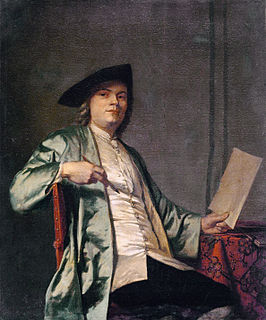
Cornelis Ploos van Amstel, was an eighteenth-century Dutch painter and art collector.

Hendrik Spilman, was an 18th-century painter and engraver from the Northern Netherlands.

Carel Isaak de Moor was an 18th-century painter from the Northern Netherlands.

Peeckelhaeringh, or Pekelharing, refers to an old Dutch word for pickled herring. Today it is best known as a jester by the same name who was the subject of a painting by Frans Hals.

Joan Michaël Fleischman, was an 18th-century German-Dutch typographer and punchcutter.

Family Group in a Landscape is a painting by the Dutch Golden Age painter Frans Hals, painted in circa 1648 and now in the Museo Thyssen-Bornemisza, Madrid.

Christiaan Josi (1768-1828) was a Dutch engraver and art dealer.
